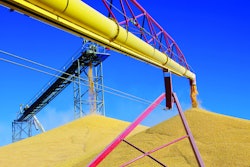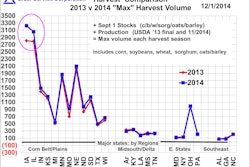
It has been quite a run for U.S. crop agriculture. With strong demand and erratic global production, grain prices have remained strong for an extended period of time, grain farm incomes have been at or near record levels, and the industries that support crop-based agriculture have (overall) enjoyed strong sales and profitability. In Indiana, for example, net farm income on grain farms from 2007-2013 exceeded $2 billion in every year except 2009, hitting a high in 2011 at $3.4 billion.
During the same period, the livestock industries in general have been under terrific pressure and livestock farm incomes have suffered. Per capita meat consumption in the U.S. is down nearly 10% from 219 pounds in 2007, to a projected 199 pounds this year. Lifestyle and diet changes may explain some of this, but Purdue agricultural economist Chris Hurt says other factors are more important: rising retail meat prices in response to higher feed costs, reductions in supply due to profit pressure and drought in key production areas, and the impact of the recession on U.S. consumer incomes plus competition for available production from export markets.
今年的丰收,由美国农业部预测在一个矩形ord 14 billion bushels of corn and near record 3.82 billion bushels of soybeans, will be a game-changer. Lower crop prices will bring profit pressure that grain farmers have not seen in several years. At the same time, prospects for the livestock industries are much more optimistic, in part buoyed by projected lower feed prices. Back to Indiana, net farm income for livestock producers is forecast at $1.1 billion this year — a figure larger than the last five years combined!
Of course, as our farmer friends remind us, “This crop is not yet in the bin.” However, in all likelihood we are at (another) turning point and a reversal of fortunes for the crop and livestock sectors with prospects rosy for livestock producers, and challenging for those producing crops. Successfully managing a feed and grain firm through these turning points is no small task and one worth significant management attention. Anticipating the implications of a business environment with lower grain prices and the adjustments they will bring for your customers and for your business is essential for future success — theirs and yours. How can you best prepare for this turning point? How can you help your employees and your customers best manage the coming transition? These are some of the questions we will consider in this issue’s Manager’s Notebook.
A changing business climate
让我们从你开始粮食生产商客户。While it is true that this crop is not yet in the bin, it is virtually certain that grain farm incomes will be down substantially this year. (Of course, it is important to note that we are coming off historic highs — expected prices are still above pre-2000 levels.) What will the likelihood of several years of lower grain prices mean for your crop producer customers? How will it affect their planting intentions next spring? What will lower grain prices mean for their input plans and agronomic service utilization? What will happen to cash rent and what are the implications for your growers? What will lower grain prices mean to their financing plans?
所有这些以及更多的问题将会和前面center for your grain farm customers.
Obviously you and your team need to give careful thought to these questions in the coming months. How will this new price regime affect the cropping mix in your area and what will a shift in crop mix mean for input/service utilization? There may be services that you have been providing where customers may reduce their utilization — or at least make your sales team work much harder to justify the use of the service.
While the overall financial condition of U.S. grain farms looks to be solid, there is no question that a period of lower prices will put some farms under financial pressure. Picking up on this last point, these turning points become important times to review your accounts with respect to financial strength. Which growers are rock solid and won’t have any trouble managing through a period of low grain prices? Which growers have expanded — possibly beyond their financial capacity and may struggle with this new price/profit environment? Importantly, which growers may use this period as a time to expand, putting their strong financial capacity to work, and perhaps acquiring additional farms/land from growers under pressure? These kinds of questions are critical as you plan your sales activities and relationship management strategy for the coming months.
At the same time, prospects for livestock producers are much more promising. Stronger prices and lower feed costs will support expansion of livestock enterprises in some areas. What will this more positive business environment and likely expansion mean for your business? What products or services may grow in demand now, as producers have additional income and are looking to grow?
You should be asking some of the same questions about your own business. How solid is your financial position? Given the answer to that question, perhaps it’s time for a more conservative approach going forward, limiting new capital investment, refilling positions a bit more slowly, delaying equipment purchases, etc. Alternatively, perhaps you’re in very strong financial shape and are well positioned to take full advantage of this turning point as competitors make their own adjustments — which may well open up opportunities for your business.
Opportunities
Let’s focus on some of the opportunities turning points can bring. As mentioned above, profitable, expanding livestock producers may well be in a position to utilize products and services that were not economically viable during a period of low prices and high feed costs. What products and services make sense now and can help livestock producers take full advantage of this current environment? As some of your producers expand, give careful thought to the specific needs they will have that your business may be well positioned to provide.
Grain producers in transition will be hungry for insight and information. At this point, we don’t fully understand the long-term implications of a bumper crop — and, we must add, this is just one year or so away from the Midwest drought of 2012, which is fresh in everyone’s memory. Your growers will be anxious for information and insights to help them make the appropriate adjustments on their farms. Marketing decisions, financing decisions, crop mix, input strategies — there will be plenty of opportunities to help your grain producing customers think through their 2015 plans.
It’s important to note here that some of your younger producers — perhaps sons and daughters who have joined the farm in the last seven years — haven’t really seen challenging economic times. The questions your growers have creates an opportunity to offer educational seminars, outside speakers (perhaps agricultural lenders) and a variety of other educational programs to provide information useful to your growers.
Likewise your own sales force will need training on the same questions. Certainly your grain producers will be looking to your salespeople for insight during this time of transition. In a conversation with a veteran salesperson recently, he made the important point that for him, the very strongest relationship building happened when he could bring a solution to a customer for a problem the customer did not yet know they had. What real “watch outs” does the coming environment bring? What things should your customers have on their radar but maybe don’t? Again, you may be able to bring in outside expertise, or utilize some of your internal talent, to help educate your customers on some of these challenges and in the process build an even deeper relationship with them!
Pressure on competitors may offer opportunity as well. Clearly different suppliers will approach this turning point from different perspectives. And, if you help your customers manage through this transition better than your competitors, it will obviously give you an edge in your market. Financial pressure always finds weaknesses and perhaps some of your competitors are not in the strongest financial position. Adjustments they make may afford you the opportunity to acquire new facilities, new locations and ultimately new business. Competitors may be forced to reduce their labor providing opportunity for you to hire some experienced employees.
Be prepared
A big part of managing turning points is to be prepared. It turns out that the Boy Scouts of America uses “Be Prepared” as the motto for boys to learn, for the same reason that you as a manager in the feed and grain industry should utilize this phrase. Being prepared means thinking things through, anticipating future events, discussing possible scenarios and developing contingency plans — preparing for these turning points.
Some of the opportunities discussed previously may come up quickly and your window to make a decision may be very brief. Sitting down with your senior management team and talking about where these potential opportunities may arise, which of them might be interesting, and which you might have the capacity to pursue — will put you in a much stronger position should an opportunity materialize.
This is definitely a time for you to think about training. You may have new employees who have not seen this type of business environment — with pressure on cash grain operations and a more positive environment supporting the expansion of livestock operations. You need to help them understand the current situation and the challenges and opportunities it creates for your customers. You also need to help them prepare for the conversations they are going to have. Training here can help them anticipate the questions that growers and producers will raise, the solutions that you want to make sure they are prepared to offer, the resistance they may meet for products and services that had previously been relatively simple sales, and so on. Training is another example of “being prepared.”
Like your customers, some of your employees may be anxious about the coming business environment. Will they have a job, what will the changes mean for their bonuses, is the business in trouble — people ask different questions during times of rapid change. By giving your employees the tools to address these uncertainties you help them build the confidence to move ahead — and that can boost the overall morale of your business team.
Managing for change
We have discussed change management in our column before (“Changes They Are A’coming — Managing Change in Your Business,” Manager’s Notebook January 2003 and “Leading Change,” Manager’s Notebook August/September 2012). Mark Harrison, author of the “Change Blog” (www.thechangeblog.com), says that people (managers) who respond well to change have a high “ambiguity threshold.” He states that since change is inherently ambiguous, those who deal creatively with change have a high tolerance for uncertainty. Where do you fit on this scale? Is there a way for you to make yourself more comfortable with change? One way that good managers deal with this is to discuss and delegate with your key folks and use them as a sounding board for ideas; let them come up with new approaches and let them implement some with your input.
Upshot
There are lots of clichés about anyone being able to manage in good times. (We don’t buy that. There are always firms/managers that perform better, no matter the business climate.) Clearly we’ve had some very good times for grain producers. At the same time it’s been an extended challenging time for livestock producers. As fortunes are expected to change and we work through this time of transition, clearly some firms and managers will struggle. At the same time, transitions create opportunities that just aren’t there during periods of prosperity.
We live and work in an industry of cycles and how we manage those cycles, those turning points, has everything to do with our long-term success. It’s unquestionably a time for you and your leadership team to step back to take a long and informed look at the future, to think carefully about what that future means for your business and your customers, to outline an action plan, and to move confidently forward with the plan.
It’s a time to fine-tune your radar, to listen carefully, and to be ready to move quickly as market conditions continue to evolve. We hope this column has given you a few things to think about as you prepare for yet another turning point in U.S. agriculture.






















